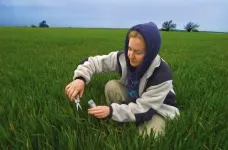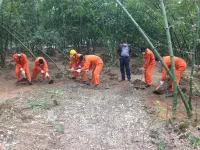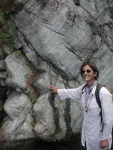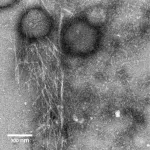(Press-News.org) If you asked people which group of animals is the most abundant on earth, hardly anyone would know the right answer. Ants? Fish? No, and not humans either. The answer is nematodes, also known as roundworms. Four out of five animals on earth belong to this group, and the reason hardly anyone is aware of the fact is that they live underground, invisible to us. Together with thousands of other soil organisms, they quietly, discreetly and constantly perform enormously important services for the world above them.
The soil is one of the most species-rich habitats in existence. Living under one square meter of healthy soil you can find up to 1.5 kilograms of organisms: among others, roundworms, earthworms, springtails, mites and insect larvae. There is also a multitude of microorganisms including bacteria, protists and fungi. They eat and transform living and dead animal and plant material into nutrients which become the basis for growth and new life. Without soil organisms, no plants would be able to grow and no humans could live.
It is therefore all the more astonishing that soils have so far hardly featured in international strategies for protecting biodiversity. The authors of the new article in Science see this as a big problem: "If we do not protect soils for the next generations, aboveground biodiversity and food production cannot be guaranteed either". Their appeal goes out to the 196 nations who are currently negotiating a new strategy to protect biodiversity within the framework of the UN Convention on Biological Diversity (CBD).
Healthy soils are becoming increasingly rare. They suffer the burden of intensive cultivation with heavy machinery, fertilisers and pesticides, are compacted, built over or are lost due to wind and water erosion. Global warming is putting them under additional pressure. According to the German Heinrich Böll Foundation, around 24 billion tons of fertile soil are lost worldwide every year. As a result, the soils' wide variety of services such as water purification and protection against plant diseases gradually decline. In addition, soils are the most important carbon reservoir on earth and therefore help slow global climate warming.
Call for greater consideration of soil biodiversity in global biodiversity protection strategies
According to the researchers, these services are given far too little attention in the political debate. "Up to now, soil conservation has been mostly reduced to the impacts related to soil erosion and its importance for agriculture," said first author Dr Carlos Guerra (iDiv, MLU). "It's about time that soil conservation policies consider the protection of soil organisms and ecosystem functions more than just for food production and other productive systems. Soil biodiversity monitoring and conservation can support the achievement and tracking of many sustainability goals, targeting areas such as climate, food and biodiversity protection."
"Protection measures have so far mainly focused on life above ground, for example in the designation of protected areas", said senior author Dr Diana Wall from Colorado State University. However, since these do not necessarily benefit underground biodiversity, the specific needs of the biotic communities in the soil have to be taken into account.
Establishing global monitoring network Soil BON
In order to be able to decide which regions of the world are particularly in need of protection, and which protective measures are appropriate, sufficient information must be available on the status and trends of biodiversity in soils. Since this has not been the case so far, the researchers launched the Soil BON monitoring network. "We want to move biodiversity in soils into the focus of conservation efforts. To do this, we must provide policymakers with the necessary information to support decision-making," said senior author Prof Nico Eisenhauer, research group leader at iDiv and Leipzig University. "Soil BON will produce and support the production of the relevant data to achieve this goal."
The purpose of Soil BON is to help gather equivalent soil data, comprehensively and over extended periods of time. What is required is an internationally recognised standard which sets out what is to be recorded and how. The researchers propose a holistic system for this: the so-called Essential Biodiversity Variables (EBVs). EBVs are key parameters for measuring biodiversity. The concept was developed by, among others, iDiv and includes criteria such as soil respiration, nutrient turnover and genetic diversity. Indicators are derived from the EBVs which then serve as a basis for soil status evaluation and subsequent decisions regarding the level and type of protection necessary for the soils.
According to the researchers, their proposed monitoring and indicator system will enable the worldwide condition of soils and their capacity to function to be recorded efficiently and monitored long term. They emphasise that it also serves as an important early warning system; with its help, it will be possible to identify, at an early stage, whether existing nature conservation goals can be achieved with current measures.
INFORMATION:
The human body is like a construction site where hundreds of thousands of different molecular nanomachines, called proteins, are simultaneously at work. Each one of these biomolecules, which are chains of amino acids essential to living organisms, perform a different biological function, often in synergy with other proteins. During their formation (the folding process) or in the performance of their biological functions, proteins change their shape in a very specific way. In many cases it is possible to conduct experiments that provide images of proteins at near atomic resolution, but only when they are in the stable and biologically ...
New research from CU Cancer Center member Jing Hong Wang, MD, PhD, and recent University of Colorado Immunology program graduate Rachel Woolaver, PhD, may help researchers develop more effective personalized immunotherapy for cancer patients.
Working within Wang's specialty of cancer immunology and head and neck squamous cell carcinomas (HNSCCs), the researchers worked to establish a mouse model that would help them understand why some hosts' immune systems reject tumors easily, while others have a harder time doing so. Their research was published last week in the Journal for ImmunoTherapy of Cancer.
"It's particularly interesting now because the field of cancer treatment has really been going in the direction of immunotherapy, ...
Researchers at the UC Davis Violence Prevention Research Program (VPRP) assessed the prevalence of exposure to violence, such as robbery or assault, and its impacts on the mental health and social functioning of California adults. Their study, published in the Journal of Interpersonal Violence, shows the far-reaching psychological effects an incident of gun violence can have on victims and those close to them.
The study's findings are based on data from 2,558 adults who responded to the 2018 California Safety and Wellbeing Survey (CSaWS). CSaWS is an ongoing survey research project on firearm ownership and the consequences of exposure to violence in California. Responses were weighted to be statistically representative of the state's adult population.
These ...
Primer on Carbon Dioxide Removal Provides Vital Resource at Critical Time
--By Julie Chao
Scientists say that any serious plan to address climate change should include carbon dioxide removal (CDR) technologies and policies, which makes the newly launched CDR Primer an especially vital resource, says Berkeley Lab scientist Margaret Torn, one of about three dozen scientists who contributed to this document.
"Atmospheric CO2 concentrations are already 50% over historic natural levels - 270 ppm (parts per million) in pre-industrial times vs 414 ppm today," said Torn. "To slow climate change and avoid its worst impacts, climate scientists tell ...
MADISON, Wis. -- As a new, apparently more transmissible version of the virus that causes COVID-19 has appeared in several countries, new research finds that the transmissibility of viral strains and the population density of a region will play big roles in how vaccination campaigns can help towns and cities return to more normal activities.
The findings suggest that directing vaccines toward densely populated counties would help to interrupt transmission of the disease. Current vaccination distribution plans don't take density into account.
Tony Ives at the University of Wisconsin-Madison and Claudio Bozzuto of the independent data research company Wildlife ...
Researchers from the University of Cambridge, the University of Milan and Google Research have used machine learning techniques to predict how proteins, particularly those implicated in neurological diseases, completely change their shapes in a matter of microseconds.
They found that when amyloid beta, a key protein implicated in Alzheimer's disease, adopts a highly disordered shape, it actually becomes less likely to stick together and form the toxic clusters which lead to the death of brain cells.
The results, reported in the journal Nature Computational Science, could aid in the future development of treatments ...
Decades after the industrialized world largely eliminated lead poisoning in children, the potent neurotoxin still lurks in one in three children globally. A new study in Bangladesh by researchers at Stanford University and other institutions finds that a relatively affordable remediation process can almost entirely remove lead left behind by unregulated battery recycling - an industry responsible for much of the lead soil contamination in poor and middle-income countries - and raises troubling questions about how to effectively eliminate the poison from children's bodies.
"Once the lead is in the environment, it stays there pretty much indefinitely ...
A new University of Saskatchewan (USask) study has found that stretching is superior to brisk walking for reducing blood pressure in people with high blood pressure or who are at risk of developing elevated blood pressure levels.
Walking has long been the prescription of choice for physicians trying to help their patients bring down their blood pressure. High blood pressure (hypertension) is a leading risk factor for cardiovascular disease and among the top preventable risk factors affecting overall mortality.
This new finding, published December 18, 2020 in the Journal of Physical Activity ...
On a beach on a remote island in eastern Papua New Guinea, a country located in the southwestern Pacific to the north of Australia, garnet sand reveals an important geologic discovery. Similar to messages in bottles that have traveled across the oceans, sediments derived from the erosion of rocks carry information from another time and place. In this case the grains of garnet sand reveal a story of traveling from the surface to deep into the Earth (~75 miles), and then returning to the surface before ending up on a beach as sand grains. Over the course of this geologic journey, the rock type changed as some minerals were changed, and other materials were included (trapped) within the newly formed garnets. The story is preserved ...
An antibacterial peptide that turns on and off
The researchers solved the 3D molecular structure of an antibacterial peptide named uperin 3.5, which is secreted on the skin of the Australian toadlet (Uperoleia mjobergii) as part of its immune system. They found that the peptide self-assembles into a unique fibrous structure, which via a sophisticated structural adaptation mechanism can change its form in the presence of bacteria to protect the toadlet from infections. This provides unique atomic-level evidence explaining a regulation mechanism of an antimicrobial ...




